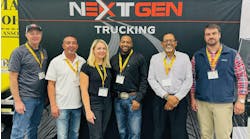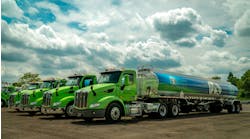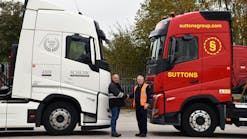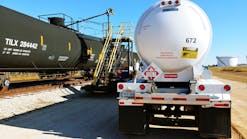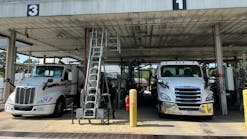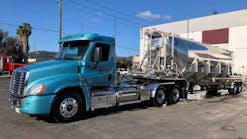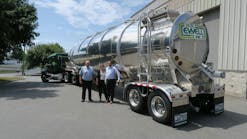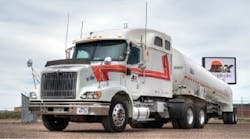When Jack B Kelley Inc won the National Tank Truck Carriers' (NTTC's) top safety award this year, management left no doubt who deserved most of the credit for the achievement. It was the company's drivers who ensure that every load is hauled safely and virtually without incident.
The industrial gases and cryogenic liquids hauler paid homage to its driver team by inviting Sheldon Seaton — a driver based at the company's Ontario, California, terminal — to attend the award presentation breakfast in San Diego. In addition, the carrier sent truck stop gift cards to its 260 drivers so they could be a part of the award breakfast even though most of them were on the road working that day.
“We wish we could have brought every one of our drivers to the award presentation breakfast, because they earned that Outstanding Performance Trophy,” says Mark Davis, Jack B Kelley (JBK) president. “We have a great driver team, and we also have an outstanding safety department under the direction of Safety Director Lee Drury. Lee worked hard to earn this trophy, and he deserves the recognition that goes with it.
“Safety is the top priority at Jack B Kelley Inc, and the commitment starts at the top at the top of our organization. Not only is it the right thing to do, it also makes good economic sense. When drivers operate safely, they take better care of the equipment.”
Ken Kelley, JBK chief executive officer, adds that the company was very honored to receive such a prestigious industry award. “A safe workplace is its own reward, but it is always good to be recognized for achievements related to safety,” he says. “The best of the best in the tank truck industry participate in the NTTC safety competition, and that makes winning a significant achievement.”
First NTTC trophy
This was the first time JBK received the Outstanding Performance Trophy, the top award in NTTC's Tank Truck Safety Contest. The carrier earned the honor with an impressive frequency of just .166 accidents per million miles in 2008. Drury also was named NTTC's 2008 Safety Director of the Year during the NTTC Safety Council annual conference in April in Savannah, Georgia.
Drury joined Davis and Seaton in accepting the Outstanding Performance Trophy during the safety award breakfast at the NTTC's 61st Annual Conference May 10-12 in San Diego, California. Seaton and his wife Monica were invited by JBK management to attend the award breakfast due to a letter of commendation from a shipper.
“We invited Sheldon (Seaton) to join us at the safety award breakfast as a representative for all of our drivers,” Davis says. “Truly, we wish all of them could have been at the breakfast, because it was their hard work that earned this trophy for our company. We chose Sheldon on the basis of a customer letter praising his safe and professional performance at a delivery location. An ex-marine, he has been a truck driver for 11 years.”
Drivers like Seaton form the core of the Jack B Kelley driver team and the front line of the safety program. “We have an outstanding driver team, and we do our best to provide all the tools they need to be safe and successful,” Drury says.
Diverse team
The driver team includes company employees and owner-operators. They handle a tractor fleet that currently totals 232 vehicles, including 70 provided by owner-operators. The carrier also runs about 250 tank trailers, most of which are designed to transport cryogenic liquids and compressed gases.
“We believe a tank truck carrier needs a good mix of company drivers and owner-operators to be successful,” Davis says. “As the economy recovers from the current recession, we'll probably add owner-operators first to meet customer demand for more transportation capacity. We like owner-operators because they are invested in their equipment, and they are very motivated.”
Every effort is made to ensure that JBK selects the best truck drivers in the business, and that is the foundation of the safety program. Oversight of the driver selection, training, and safety program resides with Drury, who joined the safety department 27 years ago and was one of the first two driver trainers. He has assembled a safety management team with more than 180 years combined experience in cryogenic liquids and transportation safety.
Driver applicants are put through a rigorous selection process. It starts with interviews by a JBK recruiter and then by the manager of the terminal where driver would be based. Following the initial interviews, the driver candidate submits an application.
Previous employers for at least the past 10 years are contacted. A criminal background check is done. JBK uses USIS and other providers to gather background information on applicants. Every driver application is reviewed by Davis, and no driver joins the company without his approval.
“This is what we mean when we say that the JBK safety program starts at the top,” Kelley says. “We set out our safety objectives and expectations with our selection process. We try to make sure driver applicants have a clear understanding of what we will expect from them.”
Once Davis gives his initial approval, a driver trainer (one of seven at JBK) accompanies the applicant on a road test that combines city and highway driving. Following a successful road test, the applicant is sent for a physical examination and drug test.
Training requirement
Next comes six days of classroom and hands-on instruction at the Corporate Training Facility near the headquarters in Amarillo, Texas. These six days in Amarillo are the beginning of a training process that continues throughout the time a driver works for this company. In fact, more retraining is being done now during the economic slowdown.
“We believe now is the ideal time to beef up our training effort,” Drury says. “This also is a good opportunity to promote safer performance on the job. Since business is slow, we have more time for refresher training. When we are busy, we don't see most of our drivers very often. We're holding mass training sessions this year, and it is paying off. We're seeing proof that our drivers and trainers have gained improved expertise with onboard technology systems such as satellite tracking and communication.”
New driver training sessions are held every other week, and typical class size is four to five students. The classroom in Amarillo can hold up to 25 students. Most of the instruction is hands on. Videos account for less than 10% of the training
Day one of the new driver program starts with instruction on employee right to know, drug and alcohol abuse, an introduction to cryogenic liquids and compressed gases, and basic details on operation of the Qualcomm satellite tracking and communication system used in the JBK fleet. Newly hired drivers begin learning about the company culture at JBK.
“We teach new drivers the history of the Kelley family and the company they built,” Drury says. “This is our opportunity to showcase the benefits of working for this company, and we talk about the company culture everyday during this orientation. If we can get a driver to stay with us for six months, we can keep him for the long-term.”
Historical perspective
Newly hired drivers are taught the personal values that made JBK a successful tank truck carrier with $75 million in revenues in 2008. The compressed gas and liquid cryogenic carrier has become one of the 25 largest US tank fleets in the industry. Getting there has taken commitment and a lot of hard work.
The company was founded in 1946 by the late Jack B Kelley and his wife, Hazel. He was an innovator in the transportation of helium and the development of tube trailers. He acquired his first cryogenic trailers in the 1960s. Throughout the next three decades, the company grew as more products and services were added, but cryogenic gases dominate the operation.
The family environment built by the Kelleys has remained strong even as the carrier expanded across most of the United States (including Alaska) and into Canada and Mexico. Today, JBK has terminals in Alabama, Arkansas, California, Florida, Georgia, Illinois, Kansas, Louisiana, Nebraska, North Carolina, Ohio, Tennessee, and Texas.
During the afternoon of day one, the newly hired drivers move from the classroom to a 15-passenger van that is outfitted with the satellite tracking and communication system. The van is used almost everyday during the orientation to teach the Smith System of Defensive Driving and the use of the satellite system. Drivers learn how to use Qualcomm's Omnivision system for electronic logs and macros for deliveries. They see how the data is used in management reports and how these reports are used by corporate managers and safety officials. Reports track over-hour violations, speeding events, critical braking events, unassigned driving, excessive idling, fuel economy, and other factors.
“Many of our new hires have never worked with electronic driver logs, and this training is critical,” Drury says. “We believe electronic logs make an important contribution to safety. We think we are relieving drivers of bookkeeping duties, which makes them safer drivers. They can concentrate on driving. Drivers say they are becoming more efficient and are able to better manage their time.
“Log-book and over-hours violations have just about disappeared. By capturing data, such as critical braking events, we believe the onboard systems have helped reduce accidents. We're also benefiting from improved customer billing processes. Our billing information is much more precise now. We used to bill in quarter-hour increments. We can now capture delivery data down to the minute.
“We've come a long way with the onboard computing and communication systems, but we still have some challenges to resolve. For instance, we have trucks operating everyday in Mexico's border zones. Unfortunately, Qualcomm's satellite tracking system shuts down at the Mexican border, and we don't know why. In Canada, the system isn't able to handle the 14-day driver logs that are allowed in that country.”
Fatigue management
Day two brings fatigue management training that JBK developed in cooperation with Circadian Technologies Inc. This is a comprehensive training and monitoring program that is designed to help drivers (as well as managers) recognize and deal with driver fatigue.
“This isn't just a driver program,” Drury says. “We started with our managers and dispatchers and expanded from there. In addition, many of our customers have become interested in the program and are working with us to help reduce fatigue-related accidents. In many cases, customers have changed start times to allow JBK drivers more time from the end of one trip to the beginning of the next one. Some customers are even using the scheduling strategy for their own drivers and shift workers.”
Trainees spend a good part of the second day getting hands-on experience in the proper ways to load and unload cryogenic liquids and compressed gases. The hands-on training is repeated every day for the remainder of the orientation program. JBK uses a 9,000-gallon liquid nitrogen tank and a 25-ton CO2 receiver for the training. JBK also has two mobile compressed-gas training units. The carrier spent more than $120,000 on the specialized training equipment.
“Our goal is to make sure that the trainees learn every skill needed to safely load and unload every product we transport,” Drury says. “The orientation program is just the start of the product handling training. For instance, it may take many months of additional training for a driver to become proficient in working with liquid hydrogen. Many of our customers have additional training requirements at their own plants.
“Deliveries are becoming more complex for many of the products we transport, and more regulations are being imposed. We deliver to hospitals and food plants where contamination is a serious concern. Our drivers absolutely must do the job correctly every time.”
Corporate tour
In addition to the hands-on drills during day three, the new hires are taken to the corporate headquarters. They meet the billing department employees who will manage their paperwork. They also meet with Davis, who stresses the importance of safety at JBK.
“I tell them that safety at JBK has evolved from a compliance focus to a companywide culture,” Davis says. “We want the safety focus to be automatic. We want drivers to do the right thing even when they aren't being watched.
“I make it clear that our safety objective is zero accidents, zero incidents, and zero personal injuries. That has been our objective since 1960, and we know it is achievable. These are not unreasonable expectations. We should be able to reach these goals every year.”
Days four, five, and six include more hands-on and classroom instruction on the handling of cryogenic and compressed gases. Throughout the orientation program, drivers are reminded that all of the training materials are available for review and reference on the JBK Intranet site.
Next step
Once the initial training in Amarillo concludes, drivers return to their home terminals and are assigned to a driver trainer. Training continues at the local level on the Smith System, electronic logs, and loading and unloading procedures until the safety department and terminal manager are satisfied that the driver is ready to run on his own. A regional trainer makes at least one round trip with the trainee to verify that he can handle the job safely and professionally.
However, that's not the end of the safety involvement for drivers. JBK management and the safety department maintain a close watch on fleet operations no matter how experienced a driver might be. This includes a management review each Monday of every safety event for the past week.
Managers and safety personnel continue to work closely with drivers. Safe performance is promoted through a semi-annual Safety & Performance Bonus Award Program. Company drivers are eligible for $100 per month of safe performance. Owner-operators can earn one cent per mile per month. Those who maintain a perfect record receive another $100 per year with the company.
JBK's “24-KARAT” program recognizes drivers for maintaining accurate logs. KARAT stands for: Knowledgeable About Rules/Regulations And Time Constraints. To qualify, drivers must have absolutely accurate time entries on their logs with no over-hour violations. Each one who qualifies receives a certificate and cap and belt buckle with the 24-KARAT designation.
The JBK safety department continually looks for ways to make the driver's work environment safer. This includes looking for ways to improve vehicle configuration. “Our goal is to keep drivers on the ground as much as possible to eliminate the potential for falls,” Drury says.
It's all part of a top-down effort to ensure that the JBK fleet is the safest on the highways. The NTTC Outstanding Performance Trophy proves that the cryogenic and compressed gases carrier is moving in the right direction. ♦
